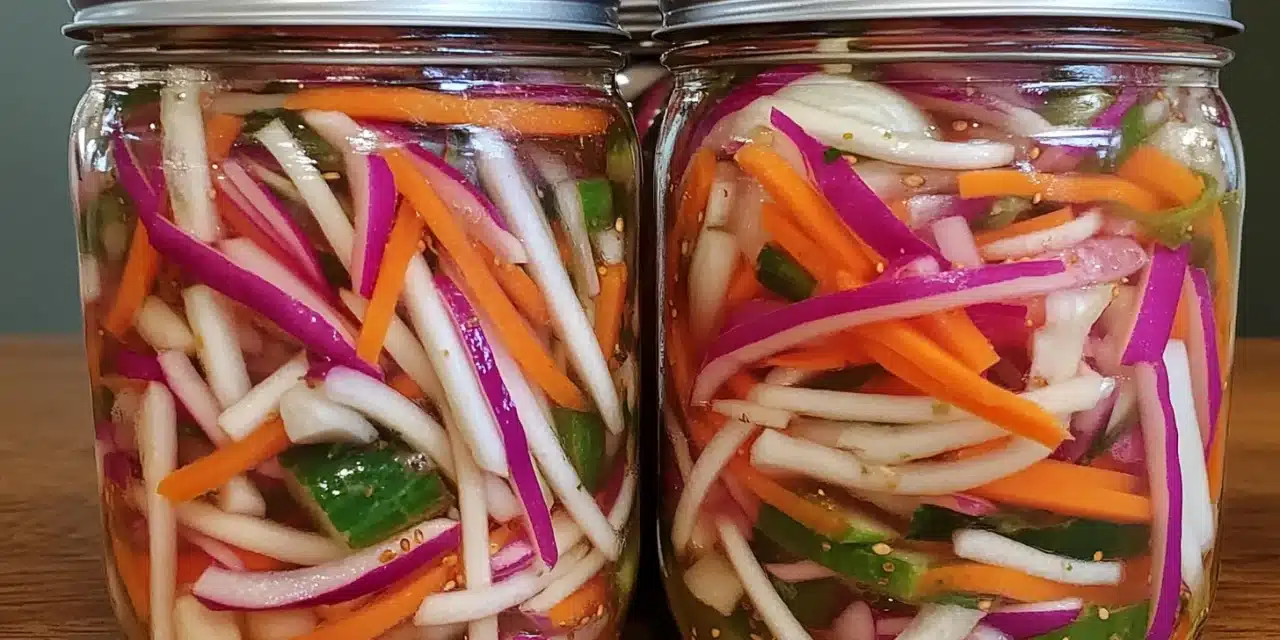Table of Contents
Introduction
Have you ever wondered how a simple Vietnamese vegetable pickle can transform an ordinary meal into a culinary adventure? Vietnamese pickles, or dưa chua, are not just a side dish—they’re a vibrant explosion of flavor, texture, and nutrition that can elevate any dining experience. This Vietnamese vegetable pickle recipe will guide you through creating a tangy, crunchy masterpiece that brings the essence of Southeast Asian cuisine right to your kitchen.
Ingredients List
Gather these fresh ingredients to create an authentic Vietnamese vegetable pickle that will tantalize your taste buds:
- 2 large carrots, julienned
- 1 daikon radish, julienned
- 1 cucumber, thinly sliced
- 1/2 cup white vinegar
- 1/2 cup water
- 2 tablespoons sugar
- 1 tablespoon salt
- 2 cloves garlic, minced
- 1 small red chili (optional, for heat)
Timing
Preparation is quick and easy—you’ll spend just 15 minutes preparing and 24 hours pickling, resulting in a condiment that’s 100% homemade and packed with flavor. Total time: 24 hours and 15 minutes.
Step-by-Step Instructions
Step 1: Prepare the Vegetables
Wash and carefully julienne your carrots and daikon radish into thin, uniform strips. The key to a perfect Vietnamese vegetable pickle is consistent cutting—aim for pieces about 2-3 inches long and 1/8 inch thick. This ensures even pickling and a beautiful presentation.
Step 2: Create the Pickling Brine
In a clean saucepan, combine vinegar, water, sugar, and salt. Heat the mixture until the sugar and salt completely dissolve, creating a balanced sweet-and-sour base for your pickle. Remove from heat and let cool to room temperature.
Step 3: Combine and Pickle
Place your prepared vegetables in a clean glass jar. Pour the cooled brine over the vegetables, ensuring they are completely submerged. Add minced garlic and chili for extra flavor. Seal the jar and refrigerate for 24 hours, allowing the flavors to meld and develop.
Nutritional Information
Per 1/4 cup serving:
- Calories: 15
- Carbohydrates: 3g
- Fiber: 1g
- Protein: 0.5g
A low-calorie, probiotic-rich condiment that supports digestive health!
Healthier Alternatives
For a low-sugar version, replace sugar with stevia or monk fruit sweetener. Those with sodium concerns can reduce salt or use a potassium-based salt substitute.
Serving Suggestions
These Vietnamese pickles are incredibly versatile! Serve alongside grilled meats, in bánh mì sandwiches, as a garnish for rice bowls, or as a tangy side dish that adds crunch and brightness to any meal.
Common Mistakes to Avoid
- Cutting Inconsistently: Uneven vegetable sizes lead to uneven pickling. Use a sharp knife or mandoline for uniform cuts.
- Using Hot Brine: Always let the brine cool to prevent vegetables from becoming soggy.
- Oversalting: Follow the recipe precisely to maintain the perfect flavor balance.
Storing Tips
Store your Vietnamese vegetable pickle in an airtight glass container in the refrigerator. They’ll stay crisp and delicious for up to 2 weeks—if they last that long!
Conclusion
Now you’re equipped to create an authentic Vietnamese vegetable pickle that will impress your family and friends. Embrace the art of pickling and bring a burst of Southeast Asian flavor to your table!
FAQs
Can I use different vegetables?
Absolutely! While carrots, daikon, and cucumber are traditional, you can experiment with other crisp vegetables like bell peppers or jicama.
Are these pickles spicy?
The recipe includes an optional chili. You can adjust the heat level or omit it entirely based on your preference.
How long do these pickles last?
Properly stored in the refrigerator, these Vietnamese vegetable pickles will remain fresh and crunchy for up to 2 weeks.






